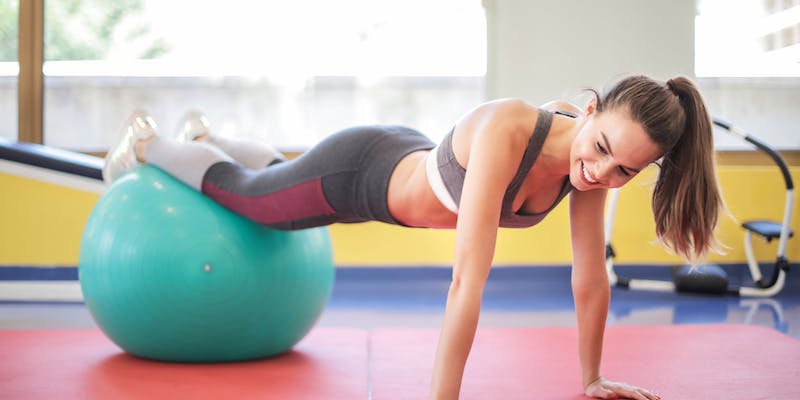Navigating Fitness: 8 Top Exercises for Managing Acid Reflux and What to Avoid
Feb 28, 2024 By Madison Evans
Acid Reflux, or GERD (Gastroesophageal Reflux Disease), is a common condition that can cause significant discomfort, but managing it can be aided with the right exercises. These exercises can help strengthen the diaphragmatic muscles, potentially reducing the frequency and intensity of acid reflux episodes. Additionally, making informed choices about physical activity can sometimes mean knowing what types of exercises to avoid to prevent worsening of GERD symptoms. This guide offers insights on the best exercises suited for individuals suffering from acid reflux, as well as those that should be approached with caution or avoided altogether. A health-conscious approach to fitness can make all the difference in living comfortably with acid reflux.
Yoga

Yoga is a gentle form of exercise that can be beneficial for managing acid reflux. It helps in strengthening the diaphragm, which plays a crucial role in supporting the lower esophageal sphincter (LES), preventing stomach acid from creeping into the esophagus. Certain yoga poses, such as the Cat-Cow Pose, can also help improve digestion and alleviate acid reflux symptoms. However, caution should be taken when practicing certain poses, such as inversions, as they can increase pressure on the abdomen and worsen GERD symptoms.
2. Pilates
Pilates is a low-impact exercise that focuses on strengthening core muscles, including the diaphragm. This can help improve posture and reduce the pressure on the LES, thus reducing acid reflux symptoms. However, as with yoga, care should be taken when practicing certain Pilates exercises that involve bending or twisting at the waist, which can put pressure on the abdomen and potentially trigger acid reflux.
3. Walking
Walking is an excellent exercise for people managing acid reflux. It's a low-impact activity that doesn't exert pressure on the stomach, reducing the risk of stomach acids flowing back into the esophagus. Regular walking not only helps with digestion but also aids in maintaining a healthy weight, which is crucial since obesity can exacerbate GERD symptoms. For the best results, it's recommended to take a leisurely walk after eating instead of lying down, as this promotes better digestion and can prevent the onset of acid reflux symptoms.
4. Swimming
Swimming is an excellent form of exercise for those with acid reflux, as it places minimal stress on the LES. The horizontal position of the body in water can reduce the likelihood of acid leaking into the esophagus. Moreover, swimming strengthens the diaphragm and promotes healthy respiratory function, which is beneficial for individuals with GERD. It’s important, however, to avoid consuming a large meal before swimming and to steer clear of movements that aggressively twist the abdomen to prevent acid reflux flare-ups. Swimming in a relaxed manner without overexertion can contribute to overall well-being and help manage GERD symptoms effectively.
5. Cycling
Cycling can be another suitable exercise for managing acid reflux, particularly because it encourages better posture and can be done at a moderate intensity. Riding a bike, especially in an upright position, can help in minimizing the pressure on the abdomen, thereby reducing the chance of acid reflux after eating. However, cyclists should be mindful not to overeat before rides and to avoid bending over too aggressively in a racing position, as this can increase intra-abdominal pressure and potentially lead to acid reflux. Stationary biking is a good alternative as it allows for control of body posture and intensity of the exercise, which can be adjusted according to one's comfort.
6. Weight Training
Weight training can be both beneficial and risky for people with acid reflux. On the one hand, building muscle mass through resistance exercises can aid in maintaining a healthy weight, potentially relieving GERD symptoms. On the other hand, exercises that increase intra-abdominal pressure—such as heavy lifting or those that involve lying flat on the back—can force stomach contents back into the esophagus, exacerbating acid reflux. It is essential to focus on moderate-intensity workouts and pay attention to form, ensuring that the abdominal muscles are not overly strained. Incorporating a rest period after eating before beginning a weight training session can also help minimize risks.
7. Tai Chi
Tai Chi, an ancient Chinese martial art form, is a low-impact exercise that involves slow, deliberate movements and controlled breathing. This can promote relaxation and reduce stress, which are both beneficial for managing acid reflux symptoms. The gentle nature of Tai Chi makes it a suitable exercise for individuals with GERD, as it does not exert pressure on the abdomen or increase intra-abdominal pressure. Certain breathing exercises can also help strengthen the diaphragm and promote better digestion, making Tai Chi a promising exercise for those with acid reflux.
8. Stretching

Stretching is an important component of any exercise routine, but it can be especially helpful for individuals with GERD. Gentle stretching exercises, such as those targeting the abdominal muscles, can help strengthen the diaphragm and improve posture, reducing pressure on the LES. This can lead to a decrease in acid reflux symptoms over time. However, it's important to avoid intense stretching exercises or those that involve twisting at the waist, as they can increase intra-abdominal pressure and potentially worsen GERD symptoms.
Conclusion
Incorporating regular exercise into a health-conscious lifestyle can help individuals with acid reflux manage their symptoms effectively. Yoga, Pilates, walking, swimming, cycling, weight training, Tai Chi, and stretching are all low-impact exercises that can benefit those with GERD. However, it's crucial to be mindful of the potential risks associated with certain exercises and to consult a doctor before beginning any new exercise routine. With the right approach and caution, physical activity can be an excellent tool in combating acid reflux and promoting overall well-being. So get moving and find the right exercise for you!

The Athlete's Guide to a Plant-Based Diet: Does It Affect Performance?

5 Essential Foods to Nourish Your Gut's Good Bacteria

Harm To The Body Brought About By Starvation

Essential Ball Exercises for Beginners: Boost Balance and Core

30 Delicious Low Carb Snacks You Can Enjoy Anytime

Nutrition Facts And Proven Health Benefits of Garlic

Accelerated Weight Loss: Discover the Best Foods, Diets, and Strategies


